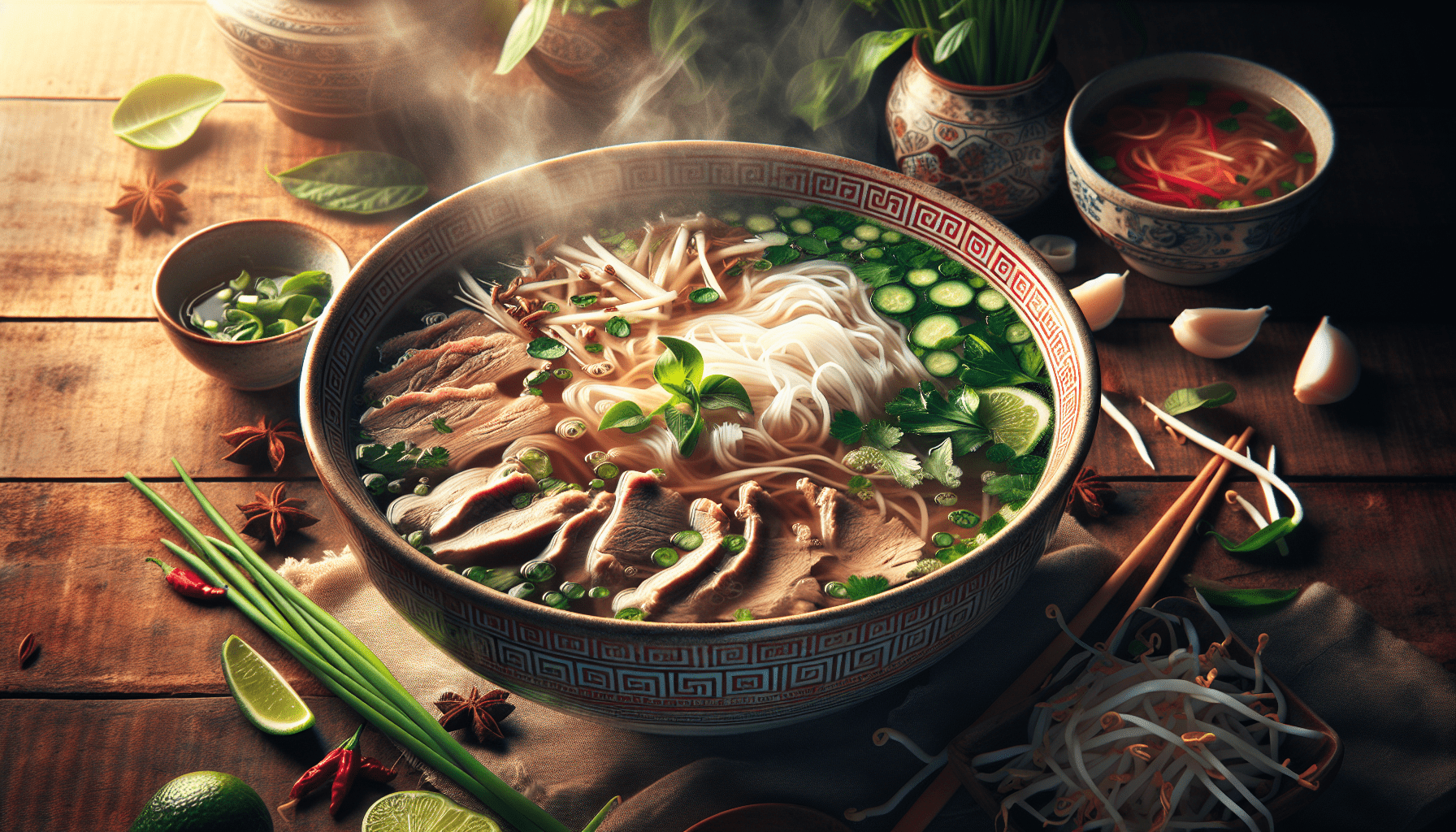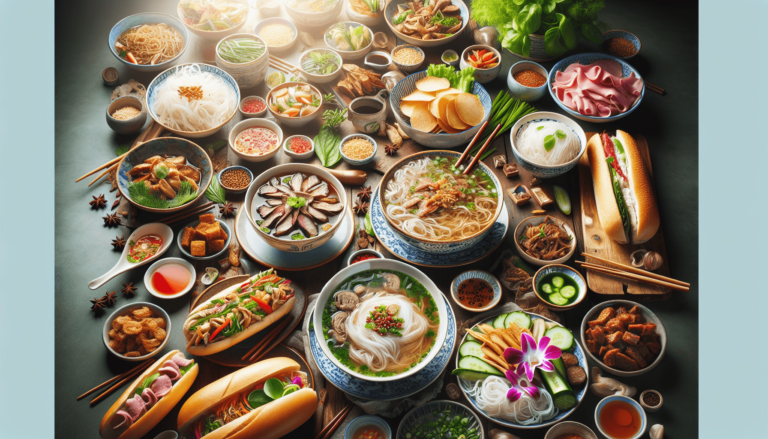If you’ve ever savored a steaming bowl of pho, you might find yourself wondering about its origins. Originating from Vietnam, pho is a tantalizing dish that has gained popularity worldwide. With its flavorful broth, tender noodles, and a medley of fresh herbs and spices, pho encapsulates the essence of Vietnamese cuisine. However, tracing the exact roots of this iconic dish can lead us on a journey through history and cultural influences. So, let’s embark on an exploration to uncover the fascinating origins of pho, immersing ourselves in the rich flavors and traditions that make it an international favorite.

Origins of Pho
First mentions of Pho in historical texts
Pho, the iconic Vietnamese dish, has a rich history that dates back several centuries. While there is limited documentation about its exact origin, the first mentions of Pho can be found in historical texts from the late 19th century. These texts describe Pho as a popular street food enjoyed by the working class in Northern Vietnam.
Northern Vietnam as the birthplace of Pho
While Pho is now enjoyed all over Vietnam, it is widely believed that the dish originated in Northern Vietnam, particularly in Hanoi. The colder climate in the region necessitated the creation of warming and nourishing dishes, and Pho was born out of this need. The region’s culinary traditions and the availability of ingredients unique to Northern Vietnam influenced the development of the dish.
Influence of Chinese and French cuisines on Pho
Pho’s development was also influenced by the culinary influences of neighboring countries. Northern Vietnam’s close proximity to China contributed to the inclusion of Chinese flavors and cooking techniques in Pho. Additionally, during the French colonial period, the French introduced beef to Vietnam, leading to the incorporation of beef into Pho, a departure from the traditional use of chicken or fish. These culinary influences gave Pho its distinctive flavor profile and contributed to its popularity.
Etymology of the Term ‘Pho’
Different theories about the origin of the word ‘Pho’
The origin of the word ‘Pho’ is a subject of debate among linguists and culinary experts. While there are several theories, it is widely accepted that the term ‘Pho’ is derived from the French word “feu,” meaning fire. The phonetic similarities between “feu” and “Pho” suggest a possible connection between the two words.
Connection between the term ‘Pho’ and Vietnamese language
In the Vietnamese language, the word ‘Pho’ is pronounced with a rising tone. The term itself is believed to have originated from the word “phở,” which means to boil or to simmer in Vietnamese. This connection suggests that the term ‘Pho’ may have been derived from the cooking process used to make the dish.
Considerations of the term ‘Pho’ in other languages
In other languages, the term ‘Pho’ may be spelled and pronounced differently, depending on the phonetic rules of each language. For example, in English, it is commonly spelled as ‘Pho,’ while in some French-speaking countries, it may be written as ‘Phở.’ Despite the variations in spelling and pronunciation, the term ‘Pho’ has become widely recognized as the name of this beloved Vietnamese dish.
Significance of Pho in Vietnamese Culture
Status of Pho as Vietnam’s national dish
Pho holds a special place in Vietnamese culture and is often considered the country’s national dish. It is a source of national pride and represents the rich culinary heritage of Vietnam. Its popularity and widespread consumption across the country further solidify its status as a cultural icon.
Pho in traditional Vietnamese celebrations
Pho plays a significant role in Vietnamese celebrations and gatherings. It is commonly served during special occasions such as Lunar New Year, weddings, and family reunions. The act of sharing a bowl of Pho with loved ones symbolizes unity, harmony, and the importance of familial bonds.
Symbolism and significance attached to Pho in Vietnam
Beyond its delicious taste, Pho holds deep symbolic meaning in Vietnamese culture. The noodles in Pho represent longevity and prosperity, while the fragrant broth signifies the importance of harmony and balance in life. The combination of fresh herbs and condiments adds layers of flavors and textures, representing the diversity and complexity of Vietnam’s cultural heritage.
Ingredients and Preparation of Pho
Discussion of traditional ingredients in Pho
Pho typically consists of a few essential ingredients, including rice noodles, broth, meat (usually beef or chicken), and a variety of herbs and condiments. The rice noodles used in Pho are flat and linguini-shaped, providing a delicate texture that complements the other components of the dish. The broth is made by simmering beef or chicken bones with a combination of spices such as star anise, cinnamon, cloves, and coriander seeds for hours, resulting in a rich and flavorful base.
Typical process of preparing Pho at home
Preparing Pho at home requires time and attention to detail. To start, the bones are boiled to remove impurities, and then simmered for hours to develop a deep, complex flavor. The broth is then strained and seasoned with additional spices and aromatics. Meanwhile, the rice noodles are blanched and placed at the bottom of a serving bowl, ready to be topped with the cooked meat and herbs. The hot broth is poured over the assembled ingredients, cooking the meat and releasing the aromatic fragrance.
Variations in Pho recipes and preparation techniques
While the traditional Pho recipe remains the foundation of the dish, variations have emerged over time, catering to different regional preferences and dietary restrictions. Vegetarian Pho, for example, replaces the meat with tofu or mushrooms, while seafood Pho incorporates shrimp or fish. Furthermore, regional variations in Vietnam, such as Pho Bac (Northern style) and Pho Nam (Southern style), offer unique flavor profiles and ingredient combinations that cater to different culinary traditions.

Distinctive Features of North and South Pho
Comparison of North and South Vietnamese Pho ingredients
The distinction between North and South Vietnamese Pho lies in the choice of ingredients. In Northern Pho, the broth leans towards a clearer and milder flavor, often made with fewer spices than the Southern counterpart. The focus is on the quality of the meat and the delicate balance of flavors. In contrast, Southern Pho features a richer and more aromatic broth, achieved by using a wider range of spices and herbs.
Differences in cooking techniques between the two styles
The cooking techniques employed in Northern and Southern Vietnam also differ. Northern Pho usually involves simmering the broth for an extended period, resulting in a clearer and lighter finish. In contrast, the Southern style involves a quicker boiling process, which contributes to the bolder flavors and darker color of the broth.
Preferences and culinary traditions in Northern and Southern Vietnam
The variations in Pho reflect the diverse culinary preferences and traditions of Northern and Southern Vietnam. The colder climate in the North may have influenced the preference for a lighter broth and simpler ingredients, while the warmer climate in the South allows for the use of a wider range of aromatic herbs and spices. These regional differences contribute to the unique culinary landscape of Vietnam.
Pho’s Journey Outside Vietnam
Introduction of Pho to other countries by immigrants
As Vietnamese immigrants settled in different parts of the world, they brought their culinary traditions with them, including the beloved dish, Pho. Countries with significant Vietnamese communities, such as France, the United States, Canada, and Australia, have embraced Pho as part of their multicultural culinary landscape.
Adaptation and evolution of Pho in immigrant communities
In these immigrant communities, Pho has undergone adaptations to suit local tastes and ingredient availability. For example, in the United States, Pho has become a popular street food and has been embraced by a wide range of cultural communities. Different regional variations and fusion interpretations have emerged, adding to the diversity of Pho dishes available outside of Vietnam.
Pho in global gastronomy and its cultural significance
Pho’s global popularity has elevated it to the realm of global gastronomy. It is now recognized as one of the most iconic dishes of Vietnamese cuisine and is celebrated for its complex flavors and soul-warming qualities. Pho represents the cross-cultural exchange and appreciation for diverse culinary traditions, demonstrating the power of food in bringing people together.
Pho’s Popularity in the United States
Initial introduction and spread of Pho in the United States
Pho first gained popularity in the United States during the late 1970s and early 1980s, following the influx of Vietnamese refugees after the Vietnam War. Initially, Pho was mainly enjoyed within Vietnamese-American communities in cities such as Los Angeles, San Francisco, and Houston. However, as more Americans were introduced to Pho’s unique flavors and textures, its popularity began to spread beyond the Vietnamese community.
Role of Pho in Vietnamese-American communities
For Vietnamese-Americans, Pho is more than just a dish; it is a symbol of their cultural heritage and a connection to their roots. Pho restaurants, often family-owned and operated, serve as gathering places where Vietnamese communities can come together and celebrate their shared traditions. These establishments play a vital role in preserving Vietnamese culinary traditions and fostering a sense of community for Vietnamese immigrants and their descendants.
Favorite Pho joints and restaurants in the United States
As Pho’s popularity continues to grow in the United States, numerous Pho establishments have garnered acclaim for their authentic and delicious offerings. From the bustling streets of Little Saigon in California to the vibrant neighborhoods of Texas and New York, Pho lovers can find countless restaurants and food stalls that serve this beloved dish. Whether it’s a well-established eatery or a hidden gem, exploring the Pho scene is a delightful adventure for any food enthusiast.
Eurasian Bistro Locations as Ideal Places to Enjoy Pho
Introduction to Eurasian Bistro’s locations and menu
For those seeking a delightful Pho experience, Eurasian Bistro offers a wonderful dining option. With multiple locations in Pensacola, Florida, Eurasian Bistro provides a cozy and welcoming ambiance where you can indulge in the flavors of Vietnam. Their menu boasts a range of Vietnamese dishes, including their signature Pho, prepared with care and authenticity.
Recommendation to visit Eurasian Bistro’s locations for Pho experience
If you find yourself in Pensacola and craving Pho, visiting one of Eurasian Bistro’s locations is highly recommended. The skilled chefs and attentive staff will ensure that your Pho experience is nothing short of exceptional. From the moment you walk in, you will be greeted with warm hospitality and the enticing aromas of Vietnamese cuisine.
Patrons’ reviews and favorites from Eurasian Bistro’s
Guests of Eurasian Bistro have consistently praised the quality of their Pho, highlighting its flavorful broth, generous portions, and fresh ingredients. Reviews often mention the friendly and attentive service, creating a pleasant dining experience. Popular favorites among patrons include the classic Beef Pho, the aromatic Chicken Pho, and the vegetarian-friendly Tofu Pho. With a diverse menu and rave reviews, Eurasian Bistro is undoubtedly a must-visit destination for Pho enthusiasts.
Homemade Pho vs. Restaurant Pho
The convenience and authenticity of homemade Pho
Preparing homemade Pho allows you to have complete control over the ingredients and flavors. You can adjust the seasonings to your preference and experiment with various combinations of meats, herbs, and condiments. Homemade Pho also offers the satisfaction of creating a dish from scratch and the joy of enjoying the fruits of your labor.
Comparison of cost and time investment for homemade Pho
While homemade Pho provides a rewarding experience, it requires a considerable time investment. Making the broth alone can take several hours, and ensuring the right balance of flavors requires patience and attention to detail. Additionally, sourcing quality ingredients may also add to the cost when preparing Pho at home. However, the joy of enjoying a lovingly prepared bowl of Pho made in your own kitchen can make the effort worthwhile.
Benefits and unique experiences of eating restaurant Pho
Enjoying Pho at a restaurant provides convenience and accessibility. Restaurants specialize in crafting authentic Pho and have the expertise and resources to ensure consistently high-quality dishes. Dining out also offers the opportunity to try different variations of Pho, explore regional specialties, and appreciate the artistry and skills of professional chefs. Restaurant Pho allows you to savor the dish without the time commitment and effort required for homemade preparations.
Preservation of Traditional Pho and its Future
Initiatives to preserve and promote traditional Pho
Efforts are being made to preserve and promote traditional Pho, both in Vietnam and abroad. Organizations, culinary schools, and chefs are working together to create awareness about the rich heritage of Pho and educate future generations on the traditional methods of preparation. These initiatives aim to safeguard the original flavors and techniques associated with Pho, ensuring its longevity and authenticity.
Innovations and trends in the evolution of Pho
While preservation of tradition is important, Pho has also evolved to cater to contemporary tastes and dietary preferences. Chefs and home cooks alike have introduced creative twists to the dish, incorporating new ingredients and flavors. Vegan and gluten-free Pho options have also gained popularity, reflecting a growing demand for plant-based and allergen-friendly alternatives.
Role of Pho in promoting Vietnamese cuisine globally
Pho’s global popularity has not only brought recognition to the dish itself but has also played a significant role in promoting Vietnamese cuisine as a whole. Pho serves as a gateway to discovering the diverse flavors and culinary traditions of Vietnam. As Pho continues to capture the hearts and palates of people around the world, it acts as a cultural ambassador, inviting individuals to explore the vibrant nuances of Vietnamese gastronomy.
In conclusion, Pho’s origins in Northern Vietnam, the significance it holds in Vietnamese culture, its journey outside of Vietnam, and its popularity in the United States and beyond all contribute to its status as one of the world’s beloved dishes. Whether enjoyed at home, in a local Pho joint, or at a renowned restaurant like Eurasian Bistro, Pho captivates the senses and offers a glimpse into the rich and diverse culinary heritage of Vietnam. As efforts are made to preserve and innovate upon traditional Pho, the future of this iconic dish remains bright, ensuring that Pho will continue to be celebrated and enjoyed for generations to come.







